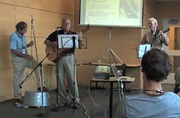- Number 322 |
- October 11, 2010
Physics folk tunes are cool as Ice

The Ear Sore Quartet, in this
case a trio, with Ice (center)
accompanied by John Cooke
(right) and the Ukrainian gut
bucket (left).
Gene Ice, a researcher at DOE's Oak Ridge National Laboratory and a UT-Battelle corporate fellow, has made his mark in the field of X-ray microdiffraction. The dynamically bent saggital-focusing optics he developed in the 1980s with legendary X-ray scientist Cullie Sparks for Brookhaven Lab's National Synchrotron Light Source were the world's first.
Ice returned to Oak Ridge in 1989 to champion X-ray microdiffraction for a new synchrotron radiation source, the Advanced Photon Source, under development at Argonne National Laboratory. In addition to helping to develop a powerful general purpose diffraction successor to the ORNL's beamline at the NSLS, Ice and Ben Larson developed a new approach to microdiffraction based on achromatic focusing optics. This work led to an R&D100 award and a powerful new X-ray microdiffraction capability for the APS.
Currently Ice is concentrating on the development of the next generation of neutron focusing optics. His research shows that achromatic focusing methods can be used to push the spatial resolution of neutron diffraction to resolve small volumes in heterogeneous materials and can improve the signal and signal-to-noise of small samples in environmental chambers. Together with the increased brilliance of the Spallation Neutron Source, this capability will allow scientists to extend the unique properties of neutrons diffraction to small and heterogeneous samples.
But Ice is gaining a reputation in another field: Folk music. The San Francisco Bay Area native is proficient on guitar and tuba He and John Cooke, a condensed-matter scientist and banjo player, form the core of the Ear Sore Quartet, which also consists of a contraption Ice calls the "Ukrainian gut-bucket."
Ice adapts traditional folk-song lyrics to physics and science topics. The result is profoundly geared to the science-attentive audience. Take this example, the "Diffuse Scattering Song" (sung to the tune of "Dark as a Dungeon").
Come eager young scholars, so tender so new
I’ll teach you diffraction, what I say’s mostly true
Between the Bragg Peaks lies a world where you see
Fluctuations and defects, they stand out plane-ly.
(Chorus) For it's dark as a dungeon between the Bragg peaks
But here in the darkness each defect speaks
It gathers from throughout reciprocal space
And re-distributes all over the place.
Between the Bragg peaks, one thing that we see
Is TDS on our CCD
Intensity totals are conserved, you can’t win
It steals from the Bragg peaks that stay very thin.
(Chorus)
You get the idea. Among their venues, the Ear Sore Quartet have entertained the Neutron and X-ray Scattering School held at Argonne and Oak Ridge annually. The NXS school introduces student researchers to potential research using both X-ray and neutron sources. Watch an Ear Sore performance at this year's banquet here.
Submitted by DOE's Oak Ridge National Laboratory
